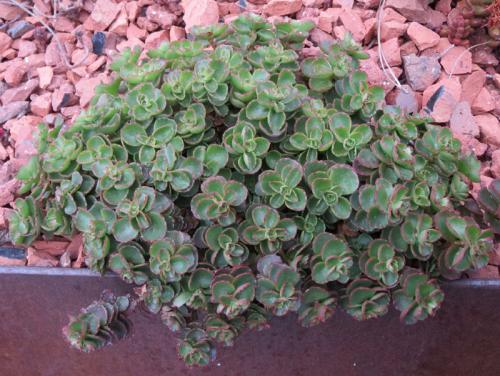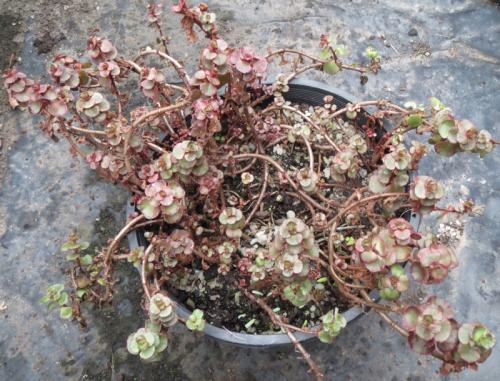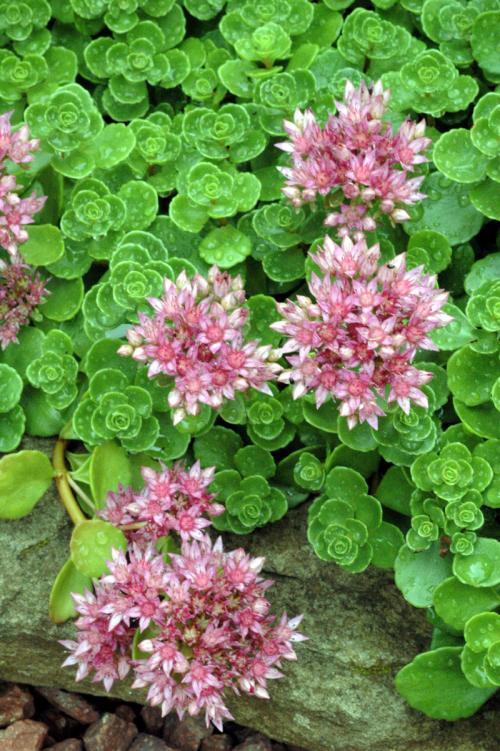SPURIUS (M. von Bieberstein) 't Hart, 1995
Synonyms :
Sedum spurium M. von Bieberstein (1808) / Asterosedum spurium (M. von Bieberstein) Grulich (1984) / Spathulata spuria (M. von Bieberstein) A.Löve & D.Löve (1985)
Crassula crenata Desfontaines (1808) / Sedum crenatum (Desfontaines) Boissier (1872)
Sedum involucratum M. von Bieberstein (1808) / Sedum spurium var. involucratum (M. von Bieberstein) Fröderström (1936)
Sedum oppositifolium Sims (1815)
Anacampseros ciliaris Haworth (1819) / Sedum ciliare (Haworth) Sweet (1826)
Anacampseros dentata Haworth (1821) / Sedum dentatum (Haworth) Haworth (1828)
Sedum denticulatum Donn ex DC (1828)
Sedum lazicum Boissier & Huet (1856)
Sedum congestum K.Koch ex Boissier (1872)
Sedum spurium var. album Trautvetter (1876)
Subgenus Phedimus.
Distribution : Georgia (Caucasus), northern Iran, north-eastern Turkey (Anatolia); rocky sites and subalpine meadows, 1250 - 3000 m; naturalized in many parts of Europe.
Description (according to IHSP, 2003) :
Perennial herbs with numerous procumbent or creeping, rooting, glabrous or somewhat papillose sterile stems, 5 - 15 cm long.
Leaves opposite or rarely altemate, sessile or shortly petiolate, spatulate to obovate or orbicular, cuneate, usually crenate in the upper part, 15 - 35 x 10 - 12 mm.
Flowering branches procumbent or ascending, papillose, 10 - 30 cm.
Inflorescences rather dense corymbs with 3 - 5 branches and 15 - 30 flowers, bracts oblanceolate to oblong, papillose.
Flowers 5-merous or rarely 6-merous, subsessile or with short pedicels, sepals deltoid-lanceolate, obtuse to acute, papillose towards tip, to 10 mm, petals erect in the lower part and usually spreading above, subovate, short- or sometimes long-mucronate, with slightly recurved tips, carinate, 7 - 12 mm, pure white to crimson, anthers red.
Cytology : 2n = 28, 42
A variable species in respect to size and dentation of the leaves and flower colour. The white-flowered forms (Sedum involucratum and S. oppositifolium) seem to be the dominant race in the north-eastern part of the range, whereas the red-flowered forms are more abundant in the western parts. However, there seems to be little use for segregate taxa regarding the cytological uniformity of the species.
White-flowered forms are more usual at the watersheds of the Euxine Alps. (R. Stephenson)
Ray Stephenson : Sedum, Cultivated Stonecrops. p.142 :
"In its numerous forms, perhaps Phedimus spurius is the most common stonecrop in cultivation. It is usually used for rapid ground cover, which ranges from white-flowered, green carpets right through to rich, purple-flowered, deep bronze carpets, with almost every combination in between. The forms with the greenest leaves usually have the lightest flowers, and through the range of wine-red, copper, and deep purple foliage, flower colour darkens. ....
This stonecrop originates from subalpine meadows in the Caucasus Range to Armenia and northern Iran, but the white-flowered form .... is said to be from drier sites. This species is an escape in many countries.
Large, flat leaves, creeping habit and evergreen nature differentiate this species from any other species. ...
The type species has pink-purple flowers and green leaves that tinge red in full sun."
This is a list of Phedimus spurius cultivars, compiled by the Sedum Society :
P. spurius 'Albus' (= Sedum oppositifolium) > very reluctant to flower
P. spurius 'Bronze Beauty'
P. spurius 'Bronze Carpet'
P. spurius 'Carneus'
P. spurius 'Coccineus'
P. spurius 'Dr. John Creech' has exceptionally small leaves and pink flowers
P. spurius 'Elizabeth'
P. spurius 'Erdblut'
P. spurius 'Fool's Gold' > a variegated plant !
P. spurius 'Fuldaglut' = improvement of 'Schorbusser Blut' / 'Dragon's Blood'
P. spurius 'Glow'
P. spurius 'Green Mantle' = P. spurius albus superbus > less reluctant to flower than P. spurius 'Albus.
P. spurius involucratus is a small form of P. spurius with huge sepals, as long or nearly as long as the petals.
P. spurius 'Leningrad White' has rather small leaves, very dense, pale flowers
P. spurius 'Pearly Pink'
P. spurius 'Pink Jewel'
P. spurius 'Purpurkissen'
P. spurius 'Purpurteppich' = 'Purple Carpet' (a form with noticeably large leaves which in spring can be brown-violet)
P. spurius 'Raspberry Red'
P. spurius 'Red Carpet'
P. spurius 'Red Rock' = a red sport of P. spurius 'Fuldaglut'.
P. spurius 'Roseus' (an old cv little different from the type species)
P. spurius 'Rotraut'
P. spurius 'Ruby Mantle'
P. spurius 'Salmoneus' (little different from the type, a North American garden form)
P. spurius 'Schorbusser Blut' = 'Dragon's Blood' (in autumn one of the darkest forms)
P. spurius 'Splendens'
P. spurius 'Tricolor' = the variegated form, vegetatively similar to P. kamtschaticus variegatus, published by Harry Mak in Photo album of succulents in color 3: 120 (Mar 2003).
P. spurius 'Voodoo'



Photos Noelene Tomlinson

Photo Ray Stephenson
To see more photos : Crassulaceae in the Cévennes mountains by Eric Barbier